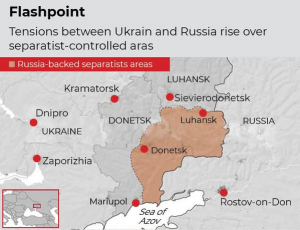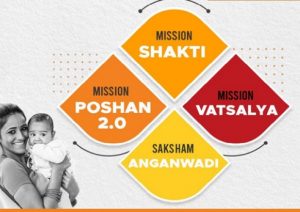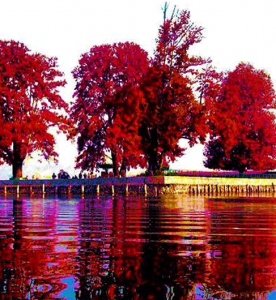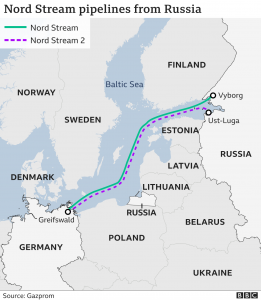THE INTERNATIONAL RELATIONS
1.THE UKRAINE’S BREAKAWAY AREAS
THE CONTEXT: Russia has formally recognised the Luhansk and Donetsk ‘People’s Republics’ in Ukraine’s Donbass.
THE EXPLANATION:
The amid tension between the Russia and Ukraine, the Russian President formally recognised the Luhansk “People’s Republic” and Donetsk “People’s Republic”, two breakaway areas of the Donbass region of Ukraine.
The President has ordered Russian troops into these areas for “peacekeeping”. The deployment is viewed as bringing Russia and the US-European alliance closer to war.
The two areas 
- Luhansk and Donetsk are areas in south-eastern Ukraine, both major industrial centres in an area collectively known as the Donbass that borders Russia. They had declared themselves independent of Ukraine in 2014, encouraged by Russia’s annexation of Crimea, but had remained unrecognised by Moscow and the international community. Western intelligence reports have spoken about the presence of Russian troops in these two areas since then, but this was denied by Russia.
- Donbass has the largest coal reserves in Ukraine. Donetsk, with a population of about 2 million, is the fifth largest city in Ukraine, and is known for a wide range of metallurgical industries. Luhansk, also an industrial city centred on metal industries, has a population of 1.5 million.
2. GERMANY SUSPENDS NORD STREAM 2 GAS PIPELINE
THE CONTEXT: Germany has taken steps to halt the process of certifying the Nord Stream 2 gas pipeline from Russia.
THE EXPLANATION:
What is Nord Stream 2?
- Nord Stream 2 is a 1,200km pipeline under the Baltic Sea, which will take gas from the Russian coast near St Petersburg to Lubmin in Germany.
- It cost €10bn (£8.4bn) and was completed September 2021. The Russian state-owned energy giant Gazprom put up half of the cost and western energy firms such as Shell and ENGIE of France are paying the rest.

- Nord Stream 2 runs parallel to an existing gas pipeline, Nord Stream, which has been working since 2011.
Why is Nord Stream 2 pipeline important for Russia?
While Europe needs Russian gas, Gazprom relies on the European market for sales to support Russian government budgets. The European Union has been able to force Gazprom to comply with many of its anti-monopoly rules in recent years.
German dependence
Germany finds itself in a precarious position. Oil and gas are the lifeblood of Germany’s manufacturing economy, but the country produces very little energy domestically and is dependent on imports for 98% of its oil and 92% of its gas supply. As of 2015, Russia already supplied the plurality of its oil and gas (40% and 35% respectively), so it was with no great surprise that plans to increase Russia’s presence were met with hostility on both sides of the Atlantic.
Nordic security
The 1,200 kilometer pipeline travels from Russia to Germany, but its proposed route enters the territorial waters and EEZ (Exclusive Economic Zone) of three other countries: Finland, Sweden and Denmark.
| QUICK FACTS
· The Nordic region, or Norden, may be defined as consisting of the five sovereign states Denmark, Finland, Iceland, Norway and Sweden. · The Scandinavian Countries: Denmark, Norway and Sweden. |
THE ENVIRONMENT AND ECOLOGY
3. INVASIVE ALIEN SPECIES THREATEN AGRICULTURE AND BIODIVERSITY IN AFRICA: STUDY
THE CONTEXT: According to a new report, the Invasive alien species (IAS) of plants, animals and microbes lead to losses running up to billions of dollars annually in every part of the world, particularly in sub-Saharan Africa. The region has seen the arrival of many IAS in recent years.
THE EXPLANATION:
- Africa may lose about $3.66 trillion annually from the impact of the IAS on agriculture and other vital food production programmes, a 2021 study showed.
- The new study was conducted in Ghana on nearly 200 potentially harmful alien plant species that can affect agriculture, forestry and biodiversity. It was led by the Centre for Agriculture and Bioscience International and published in the journal NeoBiota.
What is Invasive Alien Species?
- The International Union for the Conservation of Nature defines an alien species as a species introduced outside of its natural range. They may be brought in by people accidentally or intentionally into regions where they do not exist.
- There are around 18,000 invasive alien species around the world, according to another study by an international team of scientists from 13 countries.
- IAS cause yield loss, resulting in serious negative impacts on livelihoods. They are also responsible for the extinction or decline of many species.
THE GOVERNMENT SCHEMES AND INITIATIVES IN NEWS
4. THE CHILD WELFARE SCHEME SAW HIKE OF 390%
THE CONTEXT: According to the Union Ministry of Women and development, that a children-centric scheme of the government had seen a “390%” increase in budgetary allocations since 2014.
MISSION VATSALYA: Children have been recognized by policy makers as one of the supreme national assets. India is home to 472 million children upto the age of 18 years and comprise 39 percent of the country’s population. The objective of Mission Vatsalya is to secure a healthy and happy childhood for every child in India; foster a sensitive, supportive and synchronized ecosystem for development of children; assist States/UTs in delivering the mandate of the Juvenile Justice Act 2015; achieve the SDG goals.
Components under Mission Vatsalya will include statutory bodies; service delivery structures; institutional care/services; non-institutional community based care; emergency outreach services; training and capacity building.
Recently, the ministry of women and child development classified all of its major schemes under 3 umbrella schemes: MissionPoshan 2.0, Mission Vatsalya and Mission Shakti.
MISSION SHAKTI: It envisages a unified citizen-centric lifecycle support for women through integrated care, safety, protection, rehabilitation and empowerment to unshackle women as they progress through various stages of their life. Mission Shakti has two sub-schemes ‘Sambal’ and ‘Samarthya’. While the “Sambal” sub-scheme is for safety and security of women, the “Samarthya” sub-scheme is for empowerment of women. The Sambal sub-scheme consists of the existing scheme of One Stop Centres (OSC), Women Helplines (181-WHL) and BetiBachaoBetiPadhao (BBBP). Besides, a new component of Nari Adalats has been added as women’s collectives to promote and facilitate alternative dispute resolution and gender justice in society and within families. The “Samarthya” sub scheme is for empowerment of women, consisting of existing schemes of Ujjwala, SwadharGreh and Working Women Hostel. In addition, the National Creche Scheme for children of working mothers and the Pradhan Mantri MatruVandanaYojana (PMMVY), which have been under the Umbrella ICDS Scheme till now, are also subsumed in ‘Samarthya’.
Mission POSHAN 2.0:It is an Integrated Nutrition Support Programme. It seeks to address the challenges of malnutrition in children, adolescent girls, pregnant women and lactating mothers through a strategic shift in nutrition content and delivery and by creation of a convergent eco-system to develop and promote practices that nurture health, wellness and immunity. Poshan 2.0 will seek to optimize the quality and delivery of food under the Supplementary Nutrition Program.
Mission Poshan 2.0 will contribute to human capital development of the country; address malnutrition challenges; promote nutrition awareness and good eating habits for sustainable health & well-being and address nutrition related deficiencies through key strategies.Under the programme, nutritional norms and standards and quality and testing of THR will be improved and greater stakeholder and beneficiary participation will be promoted besides traditional community food habits.Poshan 2.0 will bring 3 important programmes/schemes under its ambit, viz., Anganwadi Services, Scheme for Adolescent Girls and PoshanAbhiyaan.
Poshan 2.0 shall focus on Maternal Nutrition, Infant and Young Child Feeding Norms, Treatment of MAM/SAM and Wellness through AYUSH. It will rest on the pillars of Convergence, Governance, and Capacity-building. Poshan Abhiyan will be the key pillar for Outreach and will cover innovations related to nutritional support, ICT interventions, Media Advocacy and Research, Community Outreach and Jan Andolan.
Mission Poshan 2.0 will integrate several key strategies to fulfil its objectives, viz., Corrective strategies, Nutrition Awareness strategies, Communication strategies and Creation of green eco-systems. The objectives under Mission Poshan 2.0 will be realized through strong interventions-driven convergent activities with key Ministries/Depts./Organizations.
Digital infrastructure under the “Poshan Tracker” rolled out by MoWCD on 1st March 2021 through National e-Governance Division as a governance tool, will strengthen and bring about transparency in nutrition delivery support systems. Technology under Poshan Tracker is being leveraged for (i) dynamic identification of stunting, wasting, under-weight prevalence among children; (ii) last mile tracking of nutrition service delivery.
THE PT PERSPECTIVE
5. THE CHAR CHINARI ISLAND ON SRINAGAR’S DAL LAKE
THE CONTEXT: The Char Chinar, the iconic tourist spot in the middle of Dal Lake in Srinagar, is set to regain its glory that had somewhat faded in the wake of the decay of three of the four majestic chinar trees from which the island got its name.
THE EXPLANATION:
- The Char Chinar, also sometimes called Char Chinari, Ropa Lank, or Rupa Lank, is an island in Dal Lake, Srinagar, Jammu and Kashmir. Dal Lake includes 3 islands, 2 of which are marked with beautiful Chinar trees.
- The island located on the Lakut Dal (small Dal) is known as Roph Lank (Silver Island), is marked with the presence of majestic Chinar trees at the four corners, thus known as Char-Chinari (Four Chinars).
- The second Chinar Island, known as Sone Lank (Gold Island), is located on the Bod Dal (Big Dal) and overlooks the holy shrine of Hazratbal.
- Chinar trees characteristically grow in Eastern Himalayas. Their botanical name is Platanus orientalis. They have been an important part of Kashmiri tradition, in that, a Chinar tree is found in almost every village in Kashmir. These trees have survived for ages, because Chinar is basically a long-living tree.
THE PRELIMS PRACTICE QUESTIONS
QUESTION OF THE DAY 23rd FEBRUARY 2022
Q1. ‘Samarthya’, is one of the two sub-schemes of umbrella scheme ‘Mission Shakti’. It does not include which of the following earlier scheme?
a) Ujjwala
b) SwadharGreh
c) Pradhan Mantri Matru Vandana Yojana
d) Beti Bachao Beti Padhao
Q2. Char Chinari island is located in which of the following?
a) Wular lake
b) Dal lake
c) Maharana Pratap Sagar
d) Harike lake
ANSWER FOR 22nd FEBRUARY 2022
Answer: D
Explanation:
Please refer to the given map:


